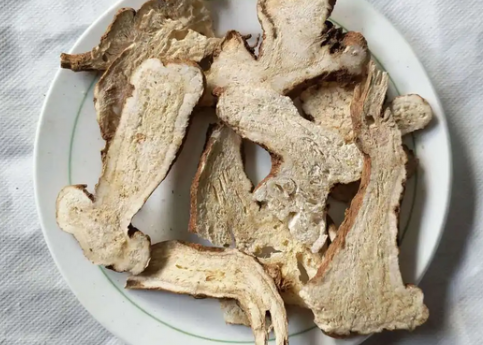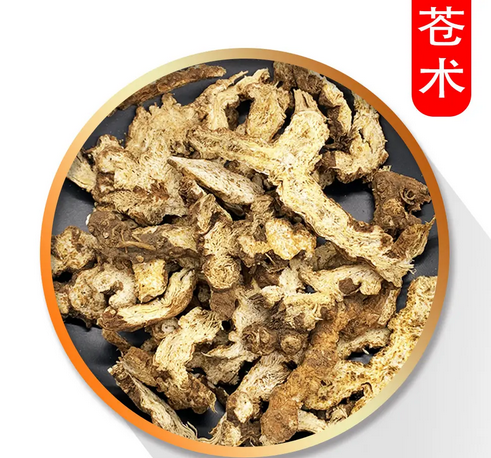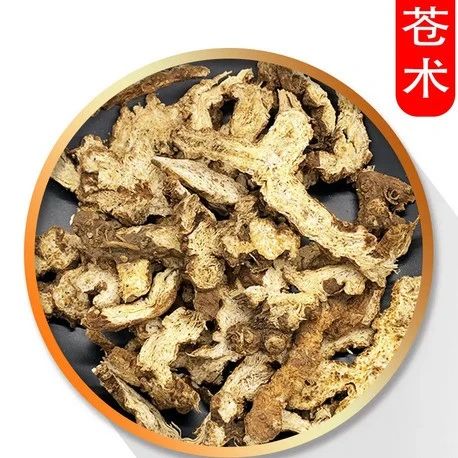Inheriting the legacy of Qi Huang, a public account with substance and warmth.
Ai Yu Xiang Tang
In the classic texts, the term “Zhu” refers to both Bai Zhu (White Atractylodes) and Cang Zhu (Atractylodes lancea), but in this context, it leans more towards Bai Zhu. According to ancient analogies, Bai Zhu has a predominantly white cross-section, while Cang Zhu appears dark blue-black. When observing the preparation of these two herbs, TCM draws analogies where white corresponds to the Lung meridian, which gathers and descends, while the blue-green color belongs to Wood, which rises and disperses. Therefore, from these two points, we can see that Bai Zhu and Cang Zhu exhibit a difference in their basic functions, with Cang Zhu being more drying and Bai Zhu being more moistening. This is because Bai Zhu contains a thicker, more viscous juice, which is evident upon tasting.
 In our future use of herbs, we often utilize Cang Zhu to dry dampness and alleviate the accumulation of damp-heat in the Middle Jiao. Why do we use Cang Zhu? Because its blue-green color corresponds to the rising energy of Wood, which is necessary to relieve stagnation in the Middle Jiao. The so-called stagnation in the Middle Earth relies on Wood to disperse; if Wood cannot relieve the Earth, it leads to disharmony between Earth and Wood. In TCM hexagrams, this is represented by the hexagram “Po” (Breaking), while the harmony between Earth and Wood is represented by the hexagram “Fu” (Return of Yang). Therefore, when there is cold-damp stagnation in the Middle Jiao, we use Cang Zhu instead of Bai Zhu. If the Middle Jiao is deficient and lacks fluids and blood, we consider using Bai Zhu, which can nourish the Spleen fluids, while Cang Zhu is more inclined to invigorate Spleen Yang. These two herbs have distinct ascending and descending effects. Bai Zhu is often used in cases of cold damage when there is dry stool, as seen in the Gui Zhi Fu Zi Tang (Cinnamon Twig and Aconite Decoction). From this perspective, Bai Zhu has a moistening effect on the stool; patients with Spleen deficiency and dry stools often benefit from using raw Bai Zhu, around 30 grams, which can yield results. Below, I will explain the original text: Bai Zhu is bitter and warm, while both Bai Zhu and Cang Zhu are bitter and warm, with Cang Zhu being slightly more intense. The bitterness can dry dampness and is effective against wind-cold-damp obstruction and necrotic tissue. This indicates the areas of action for these herbs. Both Cang Zhu and Bai Zhu enter the Middle Earth, where wind-cold-dampness predominates; if dampness is removed, obstruction cannot occur. Obstruction must remain in one place; otherwise, dampness cannot accumulate. Necrotic tissue refers to skin that has long been obstructed and decayed, akin to Huang Qi (Astragalus) which addresses chronic wind-damp sores. What does this mean? It can enter the Spleen and Stomach meridians, as the Spleen governs the muscles of the limbs and can treat ulcers. Clinically, in cases of carbuncles and ulcers, where there is significant muscle decay, appropriate medication can still allow the muscle to gradually regenerate. What about spasms? In the “Shang Han Lun” (Treatise on Cold Damage), it discusses both rigid and soft spasms in external diseases. Here, spasms refer to convulsions and disharmony of the tendons and meridians. Many herbs can treat spasms, but Bai Zhu’s role is different. When dampness accumulates in the Middle Earth, the fluids can no longer nourish the meridians, leading to spasms. This type of spasm is generally treated with Bai Zhu’s ability to transform dampness, as Bai Zhu can both transform dampness and nourish the dryness of the meridians. However, in clinical practice, to effectively treat this type of condition, Bai Zhu is often combined with Fu Ling (Poria) and Gan Jiang (Dried Ginger) to dry and disperse the fluids, thereby nourishing the meridians.
In our future use of herbs, we often utilize Cang Zhu to dry dampness and alleviate the accumulation of damp-heat in the Middle Jiao. Why do we use Cang Zhu? Because its blue-green color corresponds to the rising energy of Wood, which is necessary to relieve stagnation in the Middle Jiao. The so-called stagnation in the Middle Earth relies on Wood to disperse; if Wood cannot relieve the Earth, it leads to disharmony between Earth and Wood. In TCM hexagrams, this is represented by the hexagram “Po” (Breaking), while the harmony between Earth and Wood is represented by the hexagram “Fu” (Return of Yang). Therefore, when there is cold-damp stagnation in the Middle Jiao, we use Cang Zhu instead of Bai Zhu. If the Middle Jiao is deficient and lacks fluids and blood, we consider using Bai Zhu, which can nourish the Spleen fluids, while Cang Zhu is more inclined to invigorate Spleen Yang. These two herbs have distinct ascending and descending effects. Bai Zhu is often used in cases of cold damage when there is dry stool, as seen in the Gui Zhi Fu Zi Tang (Cinnamon Twig and Aconite Decoction). From this perspective, Bai Zhu has a moistening effect on the stool; patients with Spleen deficiency and dry stools often benefit from using raw Bai Zhu, around 30 grams, which can yield results. Below, I will explain the original text: Bai Zhu is bitter and warm, while both Bai Zhu and Cang Zhu are bitter and warm, with Cang Zhu being slightly more intense. The bitterness can dry dampness and is effective against wind-cold-damp obstruction and necrotic tissue. This indicates the areas of action for these herbs. Both Cang Zhu and Bai Zhu enter the Middle Earth, where wind-cold-dampness predominates; if dampness is removed, obstruction cannot occur. Obstruction must remain in one place; otherwise, dampness cannot accumulate. Necrotic tissue refers to skin that has long been obstructed and decayed, akin to Huang Qi (Astragalus) which addresses chronic wind-damp sores. What does this mean? It can enter the Spleen and Stomach meridians, as the Spleen governs the muscles of the limbs and can treat ulcers. Clinically, in cases of carbuncles and ulcers, where there is significant muscle decay, appropriate medication can still allow the muscle to gradually regenerate. What about spasms? In the “Shang Han Lun” (Treatise on Cold Damage), it discusses both rigid and soft spasms in external diseases. Here, spasms refer to convulsions and disharmony of the tendons and meridians. Many herbs can treat spasms, but Bai Zhu’s role is different. When dampness accumulates in the Middle Earth, the fluids can no longer nourish the meridians, leading to spasms. This type of spasm is generally treated with Bai Zhu’s ability to transform dampness, as Bai Zhu can both transform dampness and nourish the dryness of the meridians. However, in clinical practice, to effectively treat this type of condition, Bai Zhu is often combined with Fu Ling (Poria) and Gan Jiang (Dried Ginger) to dry and disperse the fluids, thereby nourishing the meridians.
In clinical practice, regarding spasm conditions related to Spleen dampness, Mr. Huang uses Fu Ling and Ze Xie (Alisma) to eliminate dampness and stop spasms. Some may say that stopping spasms requires sour and astringent herbs, but they may not realize that spasms in the meridians are dry, while in the Middle Earth, they are cold and damp. If the cold and damp in the Middle Earth do not transform, merely using Mu Guo (Papaya) and Si Wu Tang (Four Substance Decoction) can only treat the superficial symptoms, not the root cause. It is essential to distinguish whether the Middle Earth is being transformed from dampness or dried out. If it is dampness, we focus on the Middle Earth; if it is drying, we nourish the Liver Wood and Liver blood, and follow the path of nourishing water to support Wood. I see textbooks stating that pairing Huang Qin (Scutellaria) can clear heat and calm the fetus, but the key in treating cold damage is to check the pulse and symptoms to understand the underlying issues and treat accordingly. If you treat according to the symptoms, even arsenic and rhubarb can save a person, but if the treatment is incorrect, Huang Qi and Dang Shen (Codonopsis) can also harm. Therefore, understanding the reasons behind fetal movement and instability is crucial. If these are not clear, using random combinations of herbs may yield no results, or worse, may cause harm, which is often overlooked due to conventional views. For conditions like diarrhea and abdominal fullness, there are many types, and according to the “Nei Jing” (Inner Canon), treating diseases must seek the root cause. For significant and minor issues, treating the superficial symptoms is still treating the root cause. Why? If you do not understand why there is difficulty with bowel movements or abdominal fullness, then of course, the classic text implies that these three symptoms are urgent. Significant and minor issues can lead to stagnation in the body’s biochemical mechanisms, causing a series of problems. If abdominal fullness is not resolved, it leads to even greater issues. Therefore, identifying the key problems is essential; in fact, every disease is treated at the root, and those who cannot treat the root cannot treat the symptoms either.
 Jaundice, or jaundice syndrome, generally arises from internal dampness, cold-damp, or damp-heat, categorized into five types. Bai Zhu is particularly effective in the Middle Jiao, Spleen, and Stomach to transform dampness, and can serve as an auxiliary herb for these types of jaundice. Stopping sweating: what can induce sweating and what can stop it? Understanding how sweat is produced is essential to know how to stop or induce it. Without understanding physiology, one cannot discuss pathology. Normally, sweat is produced from the Middle Jiao, where the Ying and Wei Qi transform and reach the skin surface, opening the pores to sweat. Bai Zhu, as a herb, transforms dampness from the Middle Earth. Once the Middle Earth is damp, it leads to a situation where the Spleen cannot ascend and the Stomach cannot descend. The Spleen is damp, and the Stomach is dry; the Spleen is Yin, and the Stomach is Yang. The Stomach fears dryness, so it needs to be moistened and descended. The three Yin must ascend, and Yang Qi cannot be lacking. The Spleen, as a Spleen, must warm and ascend, which is the norm.
Jaundice, or jaundice syndrome, generally arises from internal dampness, cold-damp, or damp-heat, categorized into five types. Bai Zhu is particularly effective in the Middle Jiao, Spleen, and Stomach to transform dampness, and can serve as an auxiliary herb for these types of jaundice. Stopping sweating: what can induce sweating and what can stop it? Understanding how sweat is produced is essential to know how to stop or induce it. Without understanding physiology, one cannot discuss pathology. Normally, sweat is produced from the Middle Jiao, where the Ying and Wei Qi transform and reach the skin surface, opening the pores to sweat. Bai Zhu, as a herb, transforms dampness from the Middle Earth. Once the Middle Earth is damp, it leads to a situation where the Spleen cannot ascend and the Stomach cannot descend. The Spleen is damp, and the Stomach is dry; the Spleen is Yin, and the Stomach is Yang. The Stomach fears dryness, so it needs to be moistened and descended. The three Yin must ascend, and Yang Qi cannot be lacking. The Spleen, as a Spleen, must warm and ascend, which is the norm.
Sometimes, when the organs and vital energy are deficient, we need to moisten and nourish the Spleen meridian, using Da Zao (Jujube) and Bai Zhu. Why does it stop sweating? The Ying and Wei Qi develop externally; when the Ying Qi is excessive, it leads to sweating, while insufficient Wei Qi leads to skin dryness. Both Qi types originate from the Middle Jiao and reach the exterior. If the energy is insufficient, the first manifestation is similar to archery; if the force is insufficient, the arrow will not reach its target. If the energy reaches the lungs but lacks sufficient strength to gather and descend, then Yang Qi is insufficient. The first aspect is fear of wind and cold, leading to excessive sweating; with activity, sweating increases. Insufficient Wei Qi leads to excessive opening of Ying Qi, resulting in spontaneous sweating. The next point is stopping sweating and removing heat. What heat? The Ying and Wei Qi, if they can only expand and not contract, will stagnate midway, causing heat. Bai Zhu treats heat, typically sweet and warm, which can only alleviate minor heat. It cannot eliminate major heat; only pungent warmth can eliminate major heat. This is reflected in Li Dongyuan’s Bu Zhong Yi Qi Tang (Tonify the Middle and Augment the Qi Decoction). Bai Zhu’s treatment of heat reflects this; the heat from ginger and aconite is different. Pungent warmth does not eliminate major heat; it eliminates violent heat and Yang deficiency, which refers to inexplicable high fever. Sweet warmth alleviates heat due to insufficient Middle Jiao, gradually leading to heat, which is actually Yin deficiency heat. The true reason for this is that the three Yang Qi cannot descend. The left path is to warm and ascend, while the right path is to gather and descend Yang Qi. Mr. Huang uses ginger, cinnamon, and aconite for warming and ascending, but one cannot lack Sheng Di (Rehmannia), He Shou Wu (Fo-Ti), and Dang Gui (Angelica) to nourish Yin and consolidate Yang Qi. Everything grows with sunlight but also relies on rain and dew. Therefore, the foundation for the Middle Earth to transform must have both the warming and drying properties of ginger and cinnamon, as well as the consolidating properties of Rehmannia, Dang Gui, and He Shou Wu. Only when the foundation is solid can the original Yang ascend. This is the principle of nourishing water to support Wood. Conversely, today’s discussion of Huang Qi and Bai Zhu is about elevating the energy of the Middle Jiao. Only when it is sufficiently elevated can it descend. Elevation and descent occur simultaneously; there can be no descent without elevation. Mr. Huang combines Huang Qi, Bai Zhu, and Ren Shen (Ginseng) to elevate and descend the energy of the Middle Earth, which is essential for many diseases where Yang Qi does not gather. If the energy of the Upper and Middle Jiao is insufficient, one should choose Ren Shen, Huang Qi, and Bai Zhu to open the source, followed closely by the Yang Qi of the Upper Jiao to gather and descend. This is reflected in Mr. Zheng’s book, such as in the Dang Gui Bu Xue Tang (Angelica Blood-Tonifying Decoction) and other examples of nourishing Yin. Yin deficiency diseases often use Huang Qi, while in warming Yang, it is rarely used. For digestion, Bai Zhu is used to prepare decoctions, and long-term use can lighten the body and prolong life without hunger. This aspect of digestion leans more towards Cang Zhu, which has a drying and intense flavor, entering the Liver Wood. Bai Zhu is about gathering and descending, primarily associated with Metal, which has a gathering and consolidating meaning. Long-term use can lighten the body and prolong life without hunger, which should be attributed to Bai Zhu.
Content is for clinical reference only and is not professional advice.Doctors should not attempt acupuncture or medication without proper training.

